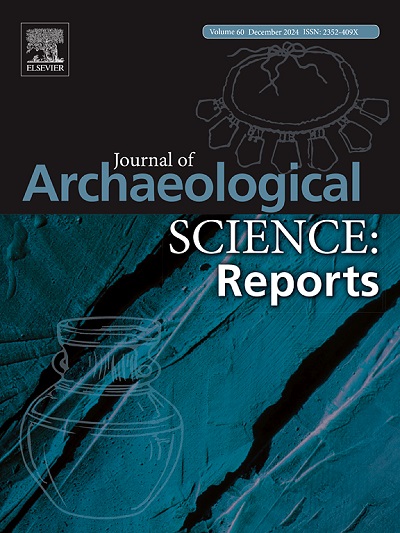量化挪威西南部卡尔莫伊岛过去 7500 年的土地使用变化,重点关注有纪念碑墓冢的三个时期
IF 1.5
2区 历史学
0 ARCHAEOLOGY
引用次数: 0
摘要
挪威西南部的卡尔莫伊岛北部拥有斯堪的纳维亚最大的古墓群之一。从青铜时代第二/三期(公元前 1300 年)到墨洛温王朝时期(公元前 550-800 年)建造的最后一批船墓,这些墓冢的规模和丰富的墓葬物品展示了三个不同时期的精英社会。在本研究中,我们重建了公元前 5500 年至公元前 2000 年的植被历史和土地使用方式,并重点研究了有墓冢的三个阶段。我们研究了精英社会的形成是由于农牧经济的盈余,还是由于岛屿靠近卡姆松海峡的战略地位。使用 REVEALS 重建了区域尺度的植被,并根据博瓦特恩湖的花粉记录和 LOVE 模型重建了地方尺度的植被。研究结果表明,公元前 2000 年左右,该地区开始出现以谷物生产为主的农业突破,森林覆盖率下降,距第一座不朽墓冢的建造还有 500-700 年。这种农业实践很可能为第一个精英社会的发展创造了所需的剩余。约公元前 1 到 500 年间,林地覆盖率在区域范围内减少到约 50%(代表第二阶段的墓葬群),而在博瓦特恩湖周围的地方范围内,林地覆盖率已经消失。畜牧业和谷物种植的同时增长表明人口在扩张。在第三阶段,即大约公元 650 年至 820 年期间,生存策略似乎更加侧重于畜牧业,而畜牧业的劳动强度较低。其中一个名为斯托豪格(Storhaug)的船墓中的花粉成分表明,周围的地貌以石南花和草地为主。随着时间的推移,靠近卡姆松海峡的战略位置变得越来越重要,尤其是在与第三阶段墓葬群相对应的时期。这项研究显示了自然景观属性与精英社会发展之间的复杂关系,以及结合考古学和古生态学数据研究过去社会变迁的益处。本文章由计算机程序翻译,如有差异,请以英文原文为准。
Quantifying the last 7500 years of land-use changes on the island of Karmøy, southwestern Norway, with focus on three periods with monumental burial mounds
The northern part of the island Karmøy in southwestern Norway contain one of Scandinavia’s largest assemblages of monumental burial mounds. The size and rich grave goods of the mounds demonstrate three separate periods of elite societies from the Bronze Age Period II/III (1300 BCE) until the final ship graves were constructed in the Merovingian Period (550–800 CE). In this study, the vegetation history and land-use practices are reconstructed from 5500 BCE to 2000 CE, with a focus on the three phases with burial mounds. We examine whether the elite societies formed due to a surplus in the agro-pastoral economy or due to the islands strategic position near the Karmsund Strait. The regional scale vegetation is reconstructed using REVEALS and the local scale vegetation is based on a pollen record from Lake Bøvatn and the LOVE model. The results show that the breakthrough of agriculture with cereal production started in the region c. 2000 BCE with a reduction in forest cover 500–700 years before the first monumental burial mounds were constructed. This agricultural practice probably created the surplus needed for the development of the first elite society. Woodland cover was reduced to c. 50 % on a regional scale between c. 1 and 500 CE (representing the second phase of burial mounds), while on a local scale around Lake Bøvatn the woodland cover was absent. A simultaneous increase in animal husbandry and cereal cultivation, suggests population expansion. During the third phase, between c. 650 and 820 CE, the subsistence strategy appears to be more focused on animal husbandry, which is less labour intensive. The pollen composition from one of the ship graves, Storhaug, indicates that the surrounding landscape was dominated by heather and grassland. The strategic location near the Karmsund Strait became increasingly important over time, especially in the period corresponding to the third phase of burial mounds. This study shows the complex relationship between physical landscape properties and the development of elite societies as well as the benefit of combining archaeological and palaeoecologial data to study past societal change.
求助全文
通过发布文献求助,成功后即可免费获取论文全文。
去求助
来源期刊

Journal of Archaeological Science-Reports
ARCHAEOLOGY-
CiteScore
3.10
自引率
12.50%
发文量
405
期刊介绍:
Journal of Archaeological Science: Reports is aimed at archaeologists and scientists engaged with the application of scientific techniques and methodologies to all areas of archaeology. The journal focuses on the results of the application of scientific methods to archaeological problems and debates. It will provide a forum for reviews and scientific debate of issues in scientific archaeology and their impact in the wider subject. Journal of Archaeological Science: Reports will publish papers of excellent archaeological science, with regional or wider interest. This will include case studies, reviews and short papers where an established scientific technique sheds light on archaeological questions and debates.
 求助内容:
求助内容: 应助结果提醒方式:
应助结果提醒方式:


